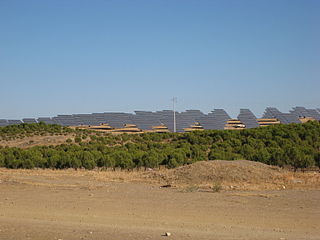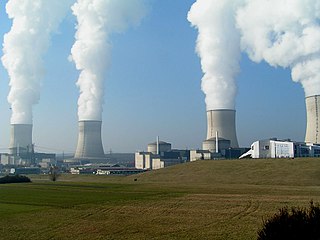
The Waldpolenz Solar Park is a 52-megawatt (MW) photovoltaic power station built by German developer and operator Juwi at a former military air base near Leipzig, Eastern Germany. When completed by the end of 2008, it was the world's largest thin-film solar park using CdTe-modules.

Solar power represented a very small part of electricity production in the United Kingdom until the 2010s when it increased rapidly, thanks to feed-in tariff (FIT) subsidies and the falling cost of photovoltaic (PV) panels.

The Moura Photovoltaic Power Station is a large photovoltaic power station in Amareleja, in the municipality of Moura, Portugal. It is one of the largest power stations of its kind, and is built in one of the sunniest regions in Europe. Its construction involved two stages: stage 1 was completed in 2008 after 13 months, and stage 2 was completed in 2010. The entire project exceeded a total cost of €250 million.

EDF Renewables is a wholly owned subsidiary of the French utility EDF Group, specializing in renewable energy production. As an integrated operator, the Group develops and finances the construction of renewable energy facilities, and manages operations and maintenance for its own account and for third parties.
The Blue Wing Solar Project is a 16.6 MWp (14.4 MWAC) solar photovoltaic (PV) power plant in San Antonio, Texas. It was one of the largest PV facilities in Texas when it came online in late 2010 and is owned by a Duke Energy Subsidiary.

The electricity sector in France is dominated by its nuclear power, which accounted for 71.7% of total production in 2018, while renewables and fossil fuels accounted for 21.3% and 7.1%, respectively. France has the largest share of nuclear electricity in the world, and together with renewable energy supplies, this has helped its grid achieve very low carbon intensity.
The Agua Caliente Solar Project is a 290 megawatt (MWAC) photovoltaic power station, built in Yuma County, Arizona using 5.2 million cadmium telluride modules made by the U.S. thin-film manufacturer First Solar. It was the largest solar facility in the world when the project was commissioned in April 2014.
Solar power in France including overseas territories reached an installed capacity figure of 11.2 GW in 2020, and rose further to 17.1 GW at the end of 2022. Government plans announced in 2022 foresee solar PV capacity in France rising to 100 GW by 2050.

Solar power in Mexico has the potential to produce vast amounts of energy. 70% of the country has an insolation of greater than 4.5 kWh/m2/day. Using 15% efficient photovoltaics, a square 25 km (16 mi) on each side in the state of Chihuahua or the Sonoran Desert could supply all of Mexico's electricity.

The Alamosa Solar Generating Plant is a 35.3 MWp (30.0 MWAC) concentrator photovoltaics (CPV) power station, the largest in the world when it was completed, in May 2012. It is currently the world's third largest operating CPV facility. The output is being sold to Public Service of Colorado, a subsidiary of Xcel Energy, under a long term Power Purchase Agreement.

Solar power in Belgium reached an installed capacity of 4,254 MW of power generating 3,563 GWh of electricity in 2018. In 2015 PV solar power accounted for around 4% of Belgium's total electricity demand, the 4th highest penetration figure in the world, although the country is some way behind the leaders Germany, Italy and Greece at between 7% and 8% of electricity demand.
In 2022 Chile produced about 18% of its electricity from solar power, up from 7% in 2018. As of 2022, Chile produces the highest percentage of its electricity from solar in the world. At the end of 2021 Chile was ranked 22nd in the world in terms of installed solar energy.
Mount Signal Solar, also known as Imperial Valley Solar Project, is a 794 MWp (614 MWAC) photovoltaic power station west of Calexico, California, United States, in the southern Imperial Valley, near the Mexican border. The facility is being developed and constructed by 8minutenergy Renewables in three phases, with two completed as of 2018. At full build-out, it will be one of the world's largest PV solar farms with a capacity of about 800 MWp (600 MWAC). The project has been supported by several environmental groups, as the power station was built on low productivity farmland.

Mohammed bin Rashid Al Maktoum Solar Park is a solar park spread over a total area of 77 km2 in Saih Al-Dahal, about 50 kilometers south of the city of Dubai. It is one of the world's largest renewable projects based on an independent power producer (IPP) model. Besides solar farms using PV technology, the long-term project will also include concentrating solar power (CSP). The total capacity of the entire project is planned to reach more than 4,000 megawatts.
The Springbok Solar Farm is a 443 MWp (350 MWAC) photovoltaic power station in the northwestern Mojave Desert, near California City in eastern Kern County, California. The facility was developed and constructed by 8minutenergy Renewables in three phases. It is among the country's largest PV solar farms with a capacity of about 440 MWp (350 MWAC).
The Beacon Solar Project is a photovoltaic power station in the northwestern Mojave Desert, near California City in eastern Kern County, California. Split into five phases, the combined Beacon solar facilities generate 250 MW of renewable energy for the Los Angeles Department of Water and Power (LADWP). The five phases of the project, fully completed in December 2017, include a total of 903,434 individual solar photovoltaic modules, mounted onto Nextracker single-axis tracking systems.
Neoen is a French producer of exclusively renewable energy headquartered in Paris, France. Founded in 2008, it develops, finances, builds and operates solar power plants, wind farms and energy storage solutions. As at 31 December 2021, the company's total capacity was 5.4 GW, made up of 50% solar, 38% wind and 12% battery storage. Neoen aims to attain 10 GW in operation and under construction by 2025.
The Crafton Hills College Solar Farm is a 1.61 MWp (1.30 MWAC) concentrator photovoltaics (CPV) power station in Yucaipa, California. It was built by Rosendin Electric using 140 dual-axis SF-1100S systems, each of which contains 28 SF-1100 modules. Each module contains reflective optics to concentrate sunlight 650 times onto multi-junction solar cells, allowing a greater efficiency than other photovoltaic power plants. The farm was constructed under California Solar Initiative (CSI) incentives and the projected annual output of 2.7 GW·h partially satisfies electricity consumption at the college.
The Metoro Solar Power Station is a 41 megawatts solar power plant in Mozambique. The power station was developed by a consortium comprising Neoen, a French independent power producer (IPP), based in Paris, France and Electricidade de Moçambique (EDM), the Mozambican electricity utility company. Construction began in October 2020, with commercial commissioning expected in the fourth quarter of 2021.
Illoulofin Solar Power Station, is a 50 megawatts (67,000 hp) solar power plant in Benin, whose first 25 MW was commissioned on 19 July 2022, and the next 25 MW is under construction and is expected to come online in 2025.









